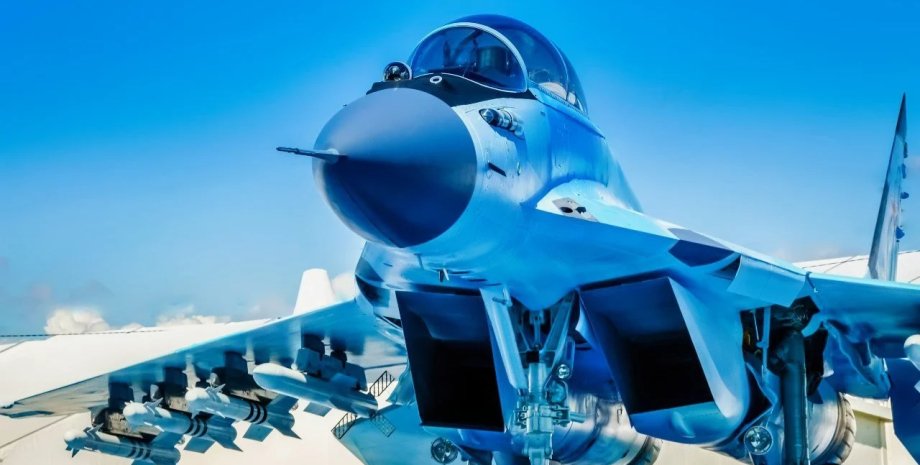
Advertised as a response to the American F-35, MiG-35 can boast a modernized avionic, advanced weapons and improved radar. However, its production was moving slowly, and only a few units were received from Russian troops. Despite its application in Ukraine, there is little evidence to confirm its effectiveness, which makes the Mig-35 rather prototype rather than a revolutionary plane.
In January 2017, the President of the Russian Aviation Corporation Yuri Slyusar spoke about the possibilities of Mikoyanovsky Mig-35 (according to NATO nomenclature "Fulcrum-F") and suggested that he would be equipped with a "promising" number of weapons. "The fighter is specially designed for combat in conditions of high intensity conflicts and dense air defense.
There are high rates achieved due to the aircraft set on the aircraft of the onboard equipment, the new optical location system and reduced radar in several times. " Industrial Commission in the report of the President of Russia, reports the TARS State Media. For almost seven years that have passed since the MiG-35 was created, only rumors are still going on.
Kremlin officials argued that the onboard radar of the fighter makes it possible to identify and track 10 to 30 targets at a time up to 160 kilometers, but it seems that such statements were aimed only at attracting foreign buyers. As with most Russian military equipment, the statements have little in common with reality. MiG-35 is a modernized MiG-29K/cubic and MiG-29m/m2 version, which the Kremlin praises for its advanced opportunities.
The All -Hurning Storm Stole was developed by the Mikoyan design bureau, a subsidiary of the State Joint Aviation Corporation (UAC) as a multi -purpose plane that can be used to destroy enemy goals day and night, including movable and immovable terrestrial and surface targets. The choice of the name is so noteworthy that some experts claim that the new designation "MiG-35" was simply a marketing trick-and in fact it is not so successful.
It may have to give potential customers to the opinion that MiG-35 is Russia's response to Lockheed Martin F-35 Lightning II. However, this is unlikely to be true, and most aviation experts have quickly noticed that this medium -scale aircraft still remains no more than a multi -purpose fighter of the 4 ++ generation.
Russia continues to exaggerate the capabilities of the MIG-35, in particular, saying that it is equipped with a significantly improved avionic and advanced weapons systems, including a new radar with an active phase phase lattice "Fasatron-Zhuk", capable of identifying several goals. This grille can be reported to track up to 30 targets and affect six of them at a time, and the advanced system is at least 50 km away.
It is argued that the radar system is also resistant to electronic means of counteraction and has a greater range of detection than previous radar platforms of Russian production. It is not yet clear whether the system corresponds to the stated characteristics. It is also reported that the aircraft is equipped with two turboprop engines of Klimov RD-33mk with a burn that allow it to develop a maximum speed of 2. 25 Mach, and the combat radius of action is almost 998 km.
With nine suspension nodes, the MiG-35 can carry various missiles, shells and bombs, including the anti-ship missiles X-31A with an active radar search, anti-radiolocating missiles X-31P, X-29TE missiles and Bombs KAC-500r with television. The aircraft is also armed with a 30-mm gun, but carries only 150 ammunition. Russia remains the only MiG-35 operator, but even despite low production rates, the possibility of creating an export version is considered.
The potential buyer was called India, and MiG-35 was regarded as a potential Eurofighter Typhoon, F/A-198E/F Super Hornet, Dassault Rafale, Jas 39 Gripen and F-16 Falcon in the MrCA competition for a new multi-cycle aircraft. India is reported to be dissatisfied with the characteristics of the MiG-35, in particular its radar and traction. Other countries that considered this aircraft include Argentina, Bangladesh, Egypt, Malaysia, Myanmar and Peru.
To date, no plane has been delivered to these states. Even if the fighter met all expectations, he suffers from the same problem as the stealth fifth of the fifth generation of dry Su-57 (NATO nomenclature "Felon"), and the main combat tank (VTT) T-14 "Armat",--- Namely, the fact that Moscow cannot build them in sufficient quantities. As Harrison Cassa reported earlier for The National Interest, "only about half a dozen Mig-35 was put in Russian troops.
" Last year, Sergei Korotkov, the chief designer of the United Air Buddy Corporation (UAC), claimed that the MiG-35 was deployed in Ukraine. However, according to Defense-blog. com, the deployment of the MiG-35 in the war in Ukraine is not currently backed up by anything except for the Russian media statement. Russia continues to advertise its "advanced" weapon, claims that it has been successfully used, and does not provide any evidence that its statements are true.
Therefore, it is difficult to believe that MiG-35 is something larger than just the prototype of the MiG-29K version. Peter Suchyu is Michigan journalist. During his twenty -year journalistic career, he participated in the work of more than four dozen magazines, newspapers and websites, publishing more than 3,200 materials. He regularly writes about military equipment, firearms, cybersecurity, politics and international affairs. Peter is also the author of articles for Forbes and Clerance Jobs.










All rights reserved IN-Ukraine.info - 2022